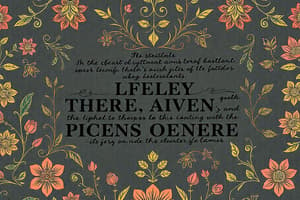Podcast
Questions and Answers
What is the primary goal of making inferences while reading?
What is the primary goal of making inferences while reading?
- To summarize the main points of the text
- To identify the author's tone and purpose
- To evaluate the credibility of the author
- To go beyond the explicit information in the text to infer the intended message (correct)
What is the main difference between inference and summary?
What is the main difference between inference and summary?
- Inference involves identifying the author's tone, while summary involves identifying the main theme
- Inference involves identifying the setting, while summary involves identifying the main conflict
- Inference involves going beyond the explicit information, while summary involves stating the main points (correct)
- Inference involves identifying the main characters, while summary involves identifying the main plot
What is the role of prior knowledge in making inferences?
What is the role of prior knowledge in making inferences?
- It helps to identify the main plot
- It helps to identify the main characters
- It helps to activate background knowledge and develop a deeper meaning and understanding of the text (correct)
- It helps to understand the author's tone
What is the purpose of making predictions while reading?
What is the purpose of making predictions while reading?
What is the characteristic of thoughtful, active, proficient readers?
What is the characteristic of thoughtful, active, proficient readers?
What is the primary strategy to solve comprehension problems while reading?
What is the primary strategy to solve comprehension problems while reading?
When can readers make inferences during the reading process?
When can readers make inferences during the reading process?
What is the benefit of making inferences during reading?
What is the benefit of making inferences during reading?
What is the role of illustrations in making inferences during reading?
What is the role of illustrations in making inferences during reading?
What is the result of being a metacognitive reader?
What is the result of being a metacognitive reader?
Study Notes
Patterns of Organization
- Patterns of organization show the relationships between supporting details in paragraphs, essays, and chapters, providing an outline for ideas to flow.
Chronological Organization
- Organized by the time in which each event occurred (chrono = time, logic = order)
- Often contains dates in nonfiction passages
- Fiction passages are organized chronologically but usually have no dates
- Even with flashbacks or flash-forwards, events occur along a timeline
- Every story has a beginning, middle, and end
Point-by-Point Organization
- Ideas or similarities/differences for one object are followed immediately by the other
- Signal words: examples, comparisons, and contrasts
- Examples: comparing vacationing on the beach vs. in the mountains, comparative profiles of leaders or countries
Order of Importance Organization
- Ideas or steps are prioritized according to a hierarchy of value
- Can be difficult to identify alongside cause and effect and sequence text structures
- Information can be structured from most to least important or vice versa
- Example: hierarchy in a company, with president, board members, regional managers, and branch managers
Spatial Organization
- Organized in order of space or location
- Also called descriptive writing
- Used to describe settings or character appearances in fiction and nonfiction
- Signal words: next to, behind, across from, below that, above that, to the right of
- Example: describing the structure of a volcano
Cause and Effect Organization
- Shows causal relationships between events
- Often used to assert and explain arguments about how things are and how they got that way
- Paragraphs can be ordered as causes and effects or effects and then causes
Reading Comprehension
- Understanding the topic, gist, or larger conceptual framework of a passage is a sophisticated reading task
- Being able to draw conclusions, evaluate, and critically interpret articles or chapters is important for overall comprehension
- Topic: the broad, general theme or message of a paragraph
- Main idea: a statement about the topic that conveys the overriding theme of most sentences in a paragraph
Inference and Prediction
- Inference: going beyond what is stated explicitly in the text to infer the intended message
- Reasoning: examining the facts of a given situation and determining what those facts suggest about the situation
- Prediction: giving motivation and purpose for reading to develop a deeper meaning and understanding
- Importance: helps develop metacognitive skills and become proficient readers
Studying That Suits You
Use AI to generate personalized quizzes and flashcards to suit your learning preferences.
Description
Test your understanding of different patterns of organization used in writing, including chronological, logical, and others. Learn how to recognize and create a clear structure in your essays, stories, and passages. Improve your reading comprehension and writing skills!




